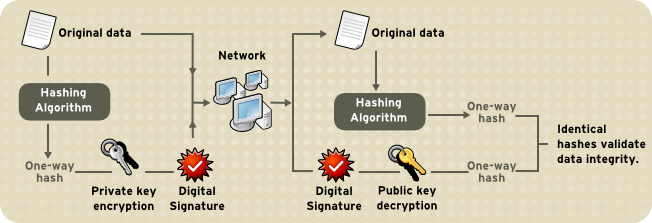Encryption and decryption address the problem of eavesdropping, one of the three Internet security issues mentioned at the beginning of this document. But encryption and decryption, by themselves, do not address another problem: tampering.
This section describes how public-key cryptography addresses the problem of tampering.
Tamper detection and related authentication techniques rely on a mathematical function called a one-way hash (also called a message digest). A one-way hash is a number of fixed length with the following characteristics:
- The value of the hash is unique for the hashed data. Any change in the data, even deleting or altering a single character, results in a different value.
- The content of the hashed data cannot, for all practical purposes, be deduced from the hash-which is why it is called "one-way."
Similarly, in public key encryption, a key pair is generated for digital signing. The key pair consists of a private signing key and a public verification key. The public key is widely distributed, while the private key is known only to its proprietor. The keys are related mathematically, but the parameters are chosen so that calculating the private key from the public key is either impossible or prohibitively expensive.The encrypted hash, along with other information, such as the hashing algorithm, is known as a digital signature.
Figure 1 shows a simplified view of the way a digital signature can be used to validate the integrity of signed data.

Figure 1 shows two items transferred to the recipient of some signed data: the original data and the digital signature, which is basically a one-way hash (of the original data) that has been encrypted with the signer's private key. To validate the integrity of the data, the receiving software first uses the signer's public key to decrypt the hash. It then uses the same hashing algorithm that generated the original hash to generate a new one-way hash of the same data. (Information about the hashing algorithm used is sent with the digital signature, although this isn't shown in the figure.) Finally, the receiving software compares the new hash against the original hash. If the two hashes match, the data has not changed since it was signed. If they don't match, the data may have been tampered with since it was signed, or the signature may have been created with a private key that doesn't correspond to the public key presented by the signer.
If the two hashes match, the recipient can be certain that the public key used to decrypt the digital signature corresponds to the private key used to create the digital signature. Confirming the identity of the signer, however, also requires some way of confirming that the public key really belongs to a particular person or other entity. For a discussion of the way this works, see "Introduction to Public-Key Cryptography."
The significance of a digital signature is comparable to the significance of a handwritten signature. Once you have signed some data, it is difficult to deny doing so later, assuming that the private key has not been compromised or out of the owner's control. This quality of digital signatures provides a high degree of nonrepudiation; that is, digital signatures make it difficult for the signer to deny having signed the data. In some situations, a digital signature may be as legally binding as a handwritten signature.
Original Document Information
- Author(s): Ella Deon Lackey
- Last Updated Date: 2012
- Copyright Information: © 2012 Red Hat, Inc.
- Link: Red Hat Certificate System Common Criteria Certification 8.1: Deployment, Planning, and Installation
